
|
The Society of Folk Dance Historians (SFDH)
Courir du Mardi Gras
[
Home |
About |
Encyclopedia | CLICK AN IMAGE TO ENLARGE |
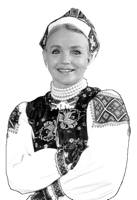
|
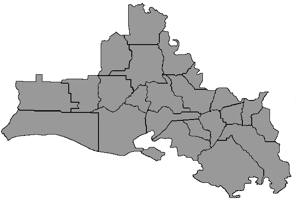 There is a group of people who live among the bayous and marshes of south-central Louisiana and the prairies of the southwest Louisiana that have resisted acculturation to a large degree, and have retained a rich ethnic identity. They are the Acadians: the French people who migrated to Louisiana to join their fellow Frenchmen, after their expulsion from Nova Scotia by the British in 1775.
There is a group of people who live among the bayous and marshes of south-central Louisiana and the prairies of the southwest Louisiana that have resisted acculturation to a large degree, and have retained a rich ethnic identity. They are the Acadians: the French people who migrated to Louisiana to join their fellow Frenchmen, after their expulsion from Nova Scotia by the British in 1775.
The terms Acadian and Cajun are used interchangeably and mean the same thing: people of Acadia. (Nova Scotia was at one time called Acadia.) Generally, when one is speaking formally, one says Acadian; and when one is speaking informally, one says Cajun. Thus Cajun is a corruption of Acadian[1].
1 Occasionally one might hear the term "coonass" used to refer to a Cajun. This might bring a smile to the faces of some Cajuns, or a look of resentment on the faces of others. Currently there is an effort to eradicate this term; it has no historic or linguistic origin, and moreover, it is basically offensive. The word came into use for the first time after World War II, and is derived from the French word "conasse," meaning a stupid, ignorant person. The military usage of the word means a prostitute without a health card.
The Acadians make up about one-third of the state's population, and in the French speaking parishes the majority of the people still speak the French language by preference. The French spoken is the same as that used by Napoleon, and it is basically a purer form of the language than what is now used on the streets of Paris. It is the old French of the 17th century.
The Acadians have kept not only their language alive but other parts of their cultural heritage as well: traditional foods are daily fare; old arts and crafts are thriving pastimes; the old Cajun straight tracks remain as popular meeting and betting places; the practice of blessing the sugar cane fields, the rice paddies, and the shrimp fleets persists as an annual ritual, traditional Cajun music flourishes, and the Cajuns' love for dancing continues with great ferver[2].
2 Many of the French-Acadian dances in Louisiana have disappeared with time, and literature on these dances is very sparse. Nevertheless, dancing is still a vital part of the Acadians' lives, and a visit to any Cajun dance hall or gathering will verify this. Although many of the traditional dances have vanished, the two-step, the polka, and the valse remain, and with a very distinctive Cajun style.
 Literally, Courir means "Running," and Mardi Gras means "Fat Tuesday" – Tuesday because it always occurs on Shrove Tuesday, and fat supposedly because it was once the custom to parade a fat ox or steer through the streets of Paris on that day. Just as likely, the term Tuesday means the day one eats well, for the next day begins the lean forty days of Lent for the Roman Catholics.
Literally, Courir means "Running," and Mardi Gras means "Fat Tuesday" – Tuesday because it always occurs on Shrove Tuesday, and fat supposedly because it was once the custom to parade a fat ox or steer through the streets of Paris on that day. Just as likely, the term Tuesday means the day one eats well, for the next day begins the lean forty days of Lent for the Roman Catholics.
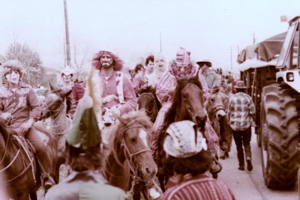 In rural Louisiana fat animals are not run through the streets, but be assured that the Cajun style of celebration is just as colorful and perhaps more fun. In the Cajun celebration, bands of masked and costumed horsemen ride through the countryside, stopping at the local farms to perform their traditional antics of dancing, singing, teasing children, and giving special attention to bashful young maidens.
In rural Louisiana fat animals are not run through the streets, but be assured that the Cajun style of celebration is just as colorful and perhaps more fun. In the Cajun celebration, bands of masked and costumed horsemen ride through the countryside, stopping at the local farms to perform their traditional antics of dancing, singing, teasing children, and giving special attention to bashful young maidens.
It is speculated that the first country celebration of Mardi Gras in Louisiana began in the 1780s, and was planned jointly by the French and Spanish settlers. A review of literature and personal inquiries reveal that the celebration was very traditional and very popular until about 1910. At that time, interest in the event diminished somewhat and even disappeared completely in some communities. Fortunately, most of the fun-loving Cajuns were not about to pass up an occasion for celebrating and the Mardi Gras went on – although not without a loss of some of its original traditions.
In recent years, such Acadian settlements as Basile, Eunice, Duralde, Ville Platte, Mamou, and Church Point celebrations have been the most constant, the largest, and the most colorful events. In 1974 in Church Point, two hundred masked and costumed riders participated in the Courir. One must usually make personal inquiries as to when the Courir in Church Point and Mamou are to be held, because very little notice of the event is given to the news media outside these local communities. Generally, the celebrations are held on the Sunday before Shrove Tuesday or on Shrove Tuesday.
The original purpose of the Courir was simply to have a very carefree time before the Lenten season began with its restrictions on personal conduct. At the same time, it was a method of foraging chickens, rice, and other provisions from local farmers, in order that these ingredients could be used in preparing the traditional gumbo feast that was served at the "fais-dodo" on the evening of Shrove Tuesday[3].
3 "Fais-dodo" literally means "go to sleep." It refers to an all-night dance, so-called perhaps because during the evenings of dancing, mothers would sing "fais-dodos" (lullabies) to put their children to sleep. All members of the family attended these dances, and when the children got tired they were put to bed in a room in back of the dance hall. The dance hall was usually an old barn or warehouse, and the fais-dodo as a building was far less impressive than the fais-dodo as an institution.
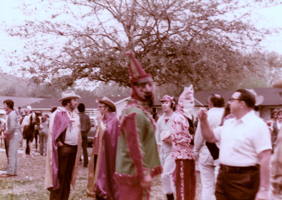 Prior to the Courir du Mardi Gras, an organizational meeting is usually held at one of the local bars; and at this time the riders plan their route, and elect a leader ("Le Capitaine") and an aide to the capitaine. Generally, the route to be followed is kept very secret, in order that spectators will be discouraged from joining the band of horsemen. The capitaine and his aide are always highly respected citizens in the community, and are usually civic or religious leaders. They are the only two riders who are not allowed to mask, for no farmer would tolerate a band of drunken masked riders on his premises unless led by leaders of integrity.
Prior to the Courir du Mardi Gras, an organizational meeting is usually held at one of the local bars; and at this time the riders plan their route, and elect a leader ("Le Capitaine") and an aide to the capitaine. Generally, the route to be followed is kept very secret, in order that spectators will be discouraged from joining the band of horsemen. The capitaine and his aide are always highly respected citizens in the community, and are usually civic or religious leaders. They are the only two riders who are not allowed to mask, for no farmer would tolerate a band of drunken masked riders on his premises unless led by leaders of integrity.
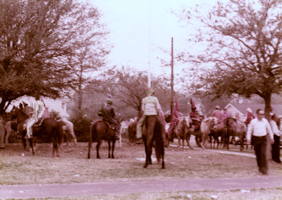 Today, as in the 18th century, mothers, wives, and girlfriends make most all parts of the men's costumes. The costume consists of a tacky, motley one-piece uniform called "le Suit de Mardi Gras," a high conical hat, similar to a dunce hat, called "le capuchon," and of course a mask. Most masks worn today are commercially made and they have largely replaced the old papier mâché screen masks that were once so prevalent. The capitaine and his aide generally wear western clothes under long, flowing capes made in the traditional Mardi Gras colors of purple and gold. They also wear western hats, carry canes, and the capitaine also carries a white flag. The horses occasionally receive their share of decorations which consist of such things as ribbons and bells tied to their manes, tails, and bridles.
Today, as in the 18th century, mothers, wives, and girlfriends make most all parts of the men's costumes. The costume consists of a tacky, motley one-piece uniform called "le Suit de Mardi Gras," a high conical hat, similar to a dunce hat, called "le capuchon," and of course a mask. Most masks worn today are commercially made and they have largely replaced the old papier mâché screen masks that were once so prevalent. The capitaine and his aide generally wear western clothes under long, flowing capes made in the traditional Mardi Gras colors of purple and gold. They also wear western hats, carry canes, and the capitaine also carries a white flag. The horses occasionally receive their share of decorations which consist of such things as ribbons and bells tied to their manes, tails, and bridles.
On the morning of the Courir, the band of grotesquely masked and garbed marauders arrive at the local bar for a few drinks and an inspection by the capitaine to make sure none of them are carrying weapons. After all, this is a mission of fun that should not be marred by acts of violence. As the sun comes up, the capitaine puts a "corne a vache" (cow's horn) to his lips, trumpets a blast, waves his flag, and "la course des Mardi Gras" is on its boisterous way to visit farms surrounding the hub (town).
|
Spoken:
1. Capitaine, capitaine, voyage ton "flag."
2. Les Mardi Gras e rassemblent une fois par an
3. Les Mardi Gras devient du tout partout.
4. Les Mardi Gras devient du tout partout. |
Captain, captain, wave your flag.
The Mardi Gras riders get together once a year.
The Mardi Gras riders come from everywhere.
The Mardi Gras riders come from everywhere; |
4 The descriptive French verses and their translations found throughout this manuscript are actually words to the song "La Danse de Mardi Gras." Although there appears to be no specific French song of which "La Danse de Mardi Gras" is a variant, it does resemble both in function and in some of its lines "La Guignolie," a begging song formerly (and perhaps somewhere still) sung in France and French Canada on New Year's Eve.
Neither rain nor mud, nor the chilly air of the season can dampen the spirits of the carefree marauders as they make their merry rounds. Any inconveniences caused by nature are readily ignored if one has a strong, sure-footed horse to ride and a flask of straight bourbon tucked in a pocket.
Upon approaching a farm house, the capitaine sounds his corne à vache; then, leaving his band of revelers behind on the road, he rides up to the farmer's doorstep to ask permission for the riders, called "Mardi Gras," to enter. In by-gone days, it was usually the custom for the waiting riders to sing a drinking song during this time. The song was characteristically Acadian in mood, and like many Cajun tunes, it used a great deal of repetition.
|
O Mardi Gras d'où tu veins?
O, Mardi Gras, quoi tu portes dans la bouteille? |
O, Mardi Gras, from where do you come?
O, Mardi Gras, what have you in your bottle? |
5 The second line evidently means "around the glass," with the superfluous words introduced to facilitate the singing. One may speculate as to why the men said they were from England. One possibility is that the only desire was to name a far-away place, and that Angleterre rhymed with cher. Another possibility is that the riders desired to convey the notion that they were bad men as perhaps Acadians thought only Englishmen could be. The words, "Yes, my dear," are used in many Acadian songs to fill in, just as the extra push-pull of the accordion is used to fill in to keep the proper tune.
It is interesting to note that at times during the Courir the riders will exchange horses as a ruse to hide their identity. It is always great fun to go to one's own house and not be recognized.
Meanwhile, the farmer has appeared at the door and the capitaine proceeds to identify his group. He proclaims, "We are the Mardi Gras!" Then he asks, "Is there anyone in this home in mourning?" If there is, the capitaine offers his sympathy, apologizes for the intrusion, and leaves with his band of riders for another farmhouse. If no one is in mourning, the capitaine asks if the master and mistress of the house will receive his followers.
|
5. Voulez-vous reçor mais cette bande des Mardi Gras?
6. Les Mardis Gras demandent mais la rentrée-z-maître et la maîtresse. |
Will you welcome this band of Mardi Gras riders?
The Mardi Gras riders ask permission to come in from the master and mistress. |
If the master and mistress are willing to receive the riders, the capitaine dips his white flag to signal that admittance has been granted. At a full gallop, the other riders enter, putting all livestock to rout and sending little children scampering to their mothers in half fear and half delight. The riders then dismount and proceed to amuse everyone (including themselves) with their antics. They make "faiter macaque" (funny faces), speak in falsetto voices, tease the children, make the farmer's daughters blush, play tricks, sing the Mardi Gras song, and sweep the ladies of the household (or each other) into a wild dance. Usually, one of the riders is designated as the "paillasse" (clown, nicknamed after a straw mattress), and he is stuffed with pillows and padding until he resembles a ball. Like a jester from the Middle Ages it is his very special duty to amuse the hosts, and it is not unusual to see him stand on his head, climb trees, pull tricks and treats from his pockets, and delight the host's children in any number of ways.
As part of their antics the riders must, of course, beg for food for the evening feast of gumbo. "Une poule gras" (a fat hen), "boudin" (Cajun sausage), "une-oeuf" (an egg), and even small change – "un cinq sou" (a nickle) – are some of the things asked for.
|
7. Connez-nous autres une 'tite poule grasse
8. Donnez-nous autres un peu de la graisse, |
Give us a little fat hen
Give us a little bit of lard, |
Having agreed to receive the Mardi Gras, the host is bound to oblige with these gifts. A high point in the merrymaking occurs when the farmer brings out the fat chicken, which must be caught by the Mardi Gras before they can claim it as their own. As the host hurls the fowl into the air, the tipsy marauders throw off their masks and a wild and hilarious chase ensues. Occasionally, some farmers will facetiously donate guinea fowls to the Mardi Gras, and these birds are particularly elusive – even to those quite sober.
Some years ago it was traditional to do a special song and dance after the chicken had been run down and the masks had been removed. It constituted the final part of the Mardi Gras' visit. The song was one to which they dance the "ridelle" (equivalent to our ring around the rosy). It called for successive touching the foot, knee, stomach, head, and back to the ground in unison with the words. Throughout the dance the paillasse kept busy flogging all erring members with a cloth quoit.
La on va danser la ridelle, allons danser la ridelle;
Pour danser la ridelle on touche le pied par terre;
Pour danser la ridelle on touche le genou par terre;
Pour danser la ridelle on touche le ventre par terre;
Pour danser la ridelle on touche la tête par terre;
Pour danser la ridelle on touche le dos par terre.
It was also a tradition in earlier years for a spring wagon loaded with a chicken coop to follow the masked band on "la course." Into this wagon was put all the "loot" gathered for the gumbo. Today, generally, no "booty" for gumbo is collected and the old spring wagon has been replaced with a Budweiser panel truck loaded with iced beer. Moreover, the gumbo is no longer cooked at the conclusion of the Courir, but during the time the riders are gone. In this way, the gumbo is ready to be served when the heroic and slightly drunken Mardi Gras return[6].
6 Even though the gumbo is no longer cooked when the riders return with their loot, the traditional way of cooking the gumbo has continued. One may wish to watch the entire preparation – even the plucking of the fowl. The gumbo preparation is started at daybreak and the spicy delicacy bubbles all day in giant iron cauldrons suspended over blazing outdoor fires. In Mamou, an old Black gentleman, who speaks only French, told the writer that he has been preparing the gumbo for the Mamou Mardi Gras for the last twenty-five years.
After the gifts from the hosts have been received, the capitaine once more blows his horn. This is to signal that it is time to give thanks to the farmer and his family, and to invite them to the gumbo feast and fais-dodo that evening.
|
9. Les Mardis Gras vous remercient bien
10. On vous invite tour pour le bal à ce soir;
11. On vous invite tous pour le gros gombo; |
The Mardi Gras riders thank you a lot
We invite you all to the dance tonight,
We invite you all for the big gumbo, |
Then with another blast of the horn the riders climb back into their saddles to continue the circuit that will eventually bring them back to their starting point.
|
12. Capitaine, capitaine, voyage ton "flag."
Spoken: |
Captain, captain, wave your flag.
|
"La course" generally ends around four in the afternoon with the tired, hungry, muddy, drunkenly carefree riders parading through the town[7]. Amidst cheers of the throngs who have been awaiting their arrival, children wave frantically to their fathers, wives proudly throw kisses to their husbands, and lovers embrace passionately. The capitaine and the local police try fruitlessly to keep the colorful procession moving down the prescribed route, while tipsy horsemen give themselves the supreme test of sobriety – standing atop their horses. Somehow, after about forty-five minutes of chaos, some order returns. Some of the riders disappear into the bars to take advantage of the free drinks offered them, and above the muffled sounds of the crowd one can hear strains of Cajun music. A street dance follows shortly with a traditional Cajun band providing the music. Some of the younger riders return to dance sensuously with their sweethearts, while older couples break into a wild Cajun two-step. Several seventy-year-old gentlemen join the orchestra's vocalist in a Cajun-French song; then suddenly they begin to dance individually with complete abandon.
7 In earlier years the Courir du Mardi Gras ran for four days, beginning on Saturday and ending on Shrove Tuesday.
As dusk appears, the savory gumbo is ready to be served, and people leave the street dancing for some good eating and a few moments of relaxation before the evening fais-dodo begins.
Judging from the writer's first-hand observation of the Courir du Mardi Gras, it is indeed a unique, colorful spectacle, and a tradition worthy of preservation. Whether it will continue or not is uncertain; however, knowing the Cajun's passion for good times, the future looks extremely promising.
POSTSCRIPT
In retrospect, two curious impressions remain with the author. Firstly, the Courir du Mardi Gras is very suggestive of ancient male initiation rites. Although this has never been implied in any literature reviewed by the writer, it appears tha Mardi Gras is a time that a young male passes from adolescence into manhood. The Mardi Gras ride, with its concomitant acts of adult revelry, is reminiscent of ritualistic tests of strength and endurance, which, upon passage, denote an acceptance into manhood.
The second impression left upon the writer is that the rural Mardi Gras resembles, to some degree, various rituals found in the Balkans and southwestern Europe. True, the Mardi Gras is European in origin – its roots having been traced back to the ancient Roman custom of merrymaking before a period of feast. Nevertheless, the relationship to European rituals is very strange indeed. For instance, consider the similarities between the Courir du Mardi Gras and the Romanian Caluș ritual. Both customs are performed by men's bands or corps and irrespective of marital status. The Caluș ritual has a leader (vataful) and an assistant to the vataful. The Louisiana Mardi Gras has a capitaine and an aide to the capitaine. Neither the vataful or the capitaine appear in costume. Both the Caluș and the Mardi Gras have flag bearers. The Caluș mute and the Louisiana paillasse play similar roles. Both groups make visits to various homes, ask permission to enter, and receive gifts. Both groups wear costumes and various decorative items. Both bands perform antics and dance, although, of course, the quality of the Calușari dancing is far superior to the Cajun dancing.
The writer is not suggesting that there is a direct relationship between the Calușari and the Mardi Gras bands, for in addition to the similarities there are many differences, including purpose. The comparison, however, does make one more curious about the roots of Mardi Gras and its development. Historically, the festivity must have been very interesting, and perhaps a great deal more complex than we generally think.
DOCUMENTS
- Cajun Music – The Soul of Acadiana, an article.
- Cajuns, a culture.
- Vonnie Brown, an article.
Used with permission of the author.
Printed in Folk Dance Scene, February 1976.
This page © 2018 by Ron Houston.
Please do not copy any part of this page without including this copyright notice.
Please do not copy small portions out of context.
Please do not copy large portions without permission from Ron Houston.